Galapagos/Day 4 Afternoon Panga Ride at Punta Vincente Roca, Isabela
|
This Brown Noddy image was created with the hand held Canon EF 200-400mm f/4L IS USM lens with Internal 1.4x Extender (at 350mm) and the Canon EOS-1D X). ISO 3200. Evaluative metering at zero: 1/500 sec. at f/4. Central sensor/AI Servo-Surround/Rear Focus AF on the side of the bird’s breast directly below the bill active at the moment of exposure. Click here if you missed the Rear Focus Tutorial. Click on the image to see a larger version.
|
Common Compositional Misunderstandings
When viewing an image like the one above, many folks will say, “The bird is too centered.” They say this either because the bird’s head is centered or because they want to apply the Rule of Thirds to all images. With field guide portraits like this, it is usually best to leave 3-4 times as much room from the tip of the bird’s bill (or in this case from the front of the bird’s breast) to the frame edge than from the tip of the tail to the opposite frame edge. In this image there is actually 11 times as much room from the front of the bird’s breast to the frame edge than from the tip of the tail to the opposite frame edge. Ideally I should have moved the active sensor one or two sensors to the left of the central sensor but I was finding that in this low light/low contrast situation that the central sensor was having an easier time AF-ing than any of the outer sensors.
Here, a big crop from the front would have put the bird’s eyes near a Rule of Thirds spot but I liked all of the cliff face habitat so I pretty much left the image design as is.
|
This Galapagos Sea Lion pup was photographed with the hand held Canon EF 200-400mm f/4L IS USM lens with Internal 1.4x Extender (at 316mm) and the Canon EOS-1D X). ISO 3200. Evaluative metering at zero: 1/640 sec. at f/4. Central sensor/AI Servo-Surround/Rear Focus AF just caught the tip of the sea lion’s nose– active at the moment of exposure. Click here if you missed the Rear Focus Tutorial. Click on the image to see a larger version. |
Sea Lion Image Design
With the image above, central sensor Surround worked just fine whether the pup was looking to my left or to my right. If it was looking to my right and I kept the central sensor on the face, it would have yielded a nice field guide type portrait. When the animal looked to my left, as in this image, a pleasing composition resulted with the animal on the right side of the frame looking to my left. I did lots of color balance work to remove the blue cast that resulted from the animal being in the shade: first I ran a 75% Average Blur Color Balance adjustment and then de-saturated the BLUE channel. I executed a small crop for the right and below to tighten up the image design.
|
This 3-frame in-camera Art Vivid HDR image was created with the hand held Canon 24-105mm f/4L IS EF USM AF Lens(at 47mm) and the Canon EOS 5D Mark III Digital camera body ISO 1600. Evaluative metering +1 2/3 stops yielded a base exposure of 1/200 sec. at f/5 in Av mode (+/-2 stops). Two sensors below the central sensor/AI Servo Rear Focus AF active at the moment of exposure. Click here if you missed the Rear Focus Tutorial. Be sure to click on the image to enjoy a larger version. |
5D III Art Vivid HDRs
I love creating HDR images but I am a very lazy man when it comes to assembling them in Photomatix. With the 5D Mark III you can create HDR images in camera. The result is a 61-mb JPEG. Just be sure to open the JPEG and save it as a TIFF and you will not run into any image quality problems.
I love the look of the Art Vivid style as seen above here. At times I use Natural. For whatever reason, you need a lot more plus compensation when creating Art Vivid HDRs than when creating Natural HDRs. I usually de-saturate the Art Vivid images about 10 points. The one thing that I know for sure is that creating them is great fun.
Note that the auto-align feature on the 5D III does a great job of aligning the three images even when you are working from a gently rocking boat so long as you are not trying to use an excessively slow shutter speed. You can, therefore, get away with hand holding in a variety of situations.
|
This 3-frame in-camera Art Vivid HDR image was created with the hand held Canon 24-105mm f/4L IS EF USM AF Lens(at 47mm) and the Canon EOS 5D Mark III Digital camera body ISO 1600. Evaluative metering +1 2/3 stops yielded a base exposure of 1/200 sec. at f/5 in Av mode (+/-2 stops). Two sensors below the central sensor/AI Servo Rear Focus AF active at the moment of exposure. Click here if you missed the Rear Focus Tutorial. Be sure to click on the image to enjoy a larger version. |
The Samba
The motor sailing yacht Samba was our home for two great weeks. The crew is wonderful and helpful. And the chef, Angel, is, as I have mentioned here before, beyond superb. Just before I began working to finish this blog post we had the most amazing lunch: fresh tuna three ways: sashimi, tartare, and seared each with its own set of savory sauces and flavors. Everyone ate until sated. That Angel pulled himself out of poverty, became a seaman, and then discovered and refined his love of cooking with formal training makes his meals that much more memorable.
The Strongest Image?
Which of the four images above do you think is the strongest? Do let us know why you made your pick.
On The Road Again
Please know that I will be traveling to and from Africa for the Tanzania Photo Safari with Todd Gustafson leaving today, August 1 and back in the office on August 21. I will have extremely limited and very slow at best internet access so please do not e-mail me until I get back. Jim will be in the office every weekday to help you with your mail order purchases and Jen will be here handling IPT registrations. The blog will continue to be active as I have prepared a dozen interesting, brand new educational posts for you in advance for you to enjoy during my absence.
Please consider using our B&H, Amazon, and Borrow Lenses affiliate links for all of your major and minor purchases both photographic and household. If we carry something in the BAA Store that you need our very great preference would be that you purchase those items from us :).
If you have a gear, image processing, or other question please e-mail me after July 19th. You can reach Jim here via e-mail. You can reach Jennifer here via e-mail. Please type “JIM” or “JEN” respectively at the front of the Subject Line.
|
Images copyright 2012: Denise Ippoltio & Arthur Morris. Card design by Denise Ippolito. Click on the image to enjoy a spectacular larger version. |
Holland 2014 7 1/2-Day/8-Night: A Creative Adventure/BIRDS AS ART/Tulips & A Touch of Holland IPT. April 17-April 24, 2014 :$4995 Limit: 12 photographers/Openings 9
This trip needs 8 registrants to run so please do not purchase your plane tickets until you hear from us; right now we need 5 more folks.
Join Denise Ippolito, Flower Queen and the author of “Bloomin’ Ideas,” and Arthur Morris, Canon Explorer of Light Emeritus and one of the planet’s premier photographic educators for a great trip to Holland in mid-April 2014. Day 1 of the IPT will be April 17, 2014. We will have a short afternoon get-together and then our first photographic session at the justly-famed Keukenhof. Most days we will return to the hotel for lunch, image sharing and a break. On Day 8, April 24, we will enjoy both morning and afternoon photography sessions.
The primary subjects will be tulips and orchids at Keukenhof and the spectacularly amazing tulip, hyacinth, and daffodil bulb fields around Lisse. In addition we will spend one full day in Amsterdam. There will be optional visits the Van Gogh Museum in the morning and the Anne Frank House in the afternoon; there will be plenty of time for street photography as well. And some great food. On another day we will have a wonderful early dinner at Kinderdijk and then head out with our gear to photograph the windmills and possibly some birds for those who bring their longs lenses. We will spend an afternoon in the lovely Dutch town of Edam where we will do some street photography and enjoy a superb dinner. All lodging, ground transportation, entry fees, and meals (from dinner on Day 1 through dinner on Day 8) are included.
For those who will be bringing a big lens we will likely have an optional bird photography afternoon or two. If we get lucky, the big attraction should be gorgeous Purple Herons in flight at a breeding marsh. We would be photographing them from the roadside. And we might be able to find a few Great-crested Grebes at a location near Keukenhof.
Click here for complete details and some previously unpublished images. And/or click here and see item one for lots more tulip photos and complete trip details.
Click here for complete details and some previously unpublished images. And/or click here and see item one for lots more tulip photos and complete trip details.
|
Images courtesy of and copyright 2012: Bill Mueller. Card design by Denise Ippolito. |
Old Car City Creative Photography In-the-Field HDR Workshop: Sunday, October 13, 2013/ 9am till 1pm.
White, Georgia: $250 plus a $15 entrance fee donation (cash only on the day of the event) that will go to charity. Limit: 16 photographers.
On October 13, 2013, Arthur Morris/BIRDS AS ART and Denise Ippolito/A Creative Adventure will be conducting an In-the-Field HDR Workshop at Old Car City in White, Georgia. Old Car City is about an hour north of Atlanta, GA and an hour south of Chattanooga, TN where they will, as noted above, be doing a full day seminar for the Photographic Society of Chattanooga on Saturday, October 12th. Click here for complete details.
Typos
On all blog posts, feel free to e-mail or leave a comment regarding any typos, wrong words, misspellings, omissions, or grammatical errors. Just be right. 🙂
Support the BAA Blog. Support the BAA Bulletins: Shop B&H here!
We want and need to keep providing you with the latest free information, photography and Photoshop lessons, and all manner of related information. Show your appreciation by making your purchases immediately after clicking on any of our B&H or Amazon Affiliate links in this blog post. Remember, B&H ain’t just photography!




Support the Blog


Amazon
Everyone buys something from Amazon, be it a big lens or deodorant. Support the blog by starting your search by typing in the little white box below. No purchase is too small to be appreciated; they all add up. Why make it a habit? Because I make it a habit of bringing you new images and information on an almost daily basis.
And from the BAA On-line Store:
LensCoats. I have a LensCoat on each of my big lenses to protect them from nicks and thus increase their re-sales value. All my big lens LensCoat stuff is in Hardwood Snow pattern.
LegCoat Tripod Leg Covers. I have four tripods active and each has a Hardwood Snow LegCoat on it to help prevent further damage to my tender shoulders 🙂 And you will love them in mega-cold weather….
Gitzo GT3532 LS CF Tripod. This one replaces the GT3530LS Tripod and will last you a lifetime. Learn more about this great tripod here.
Mongoose M3.6 Tripod Head. Right now this is the best tripod head around for use with lenses that weigh less than 9 pounds. For heavier lenses, check out the Wimberley V2 head.
Double Bubble Level. You will find one in my camera’s hot shoe whenever I am not using flash.
The Lens Align Mark II. I use the Lens Align Mark II pretty much religiously to micro-adjust all of my gear an average of once a month and always before a major trip. Enjoy our free comprehensive tutorial here.
BreezeBrowser. I do not see how any digital photographer can exist without this program.
Delkin Flash Cards. I use and depend on Delkin compact Flash Cards and card readers most every day. Learn more about their great 700X and 1000X cards here or about my favorite Delkin card here.

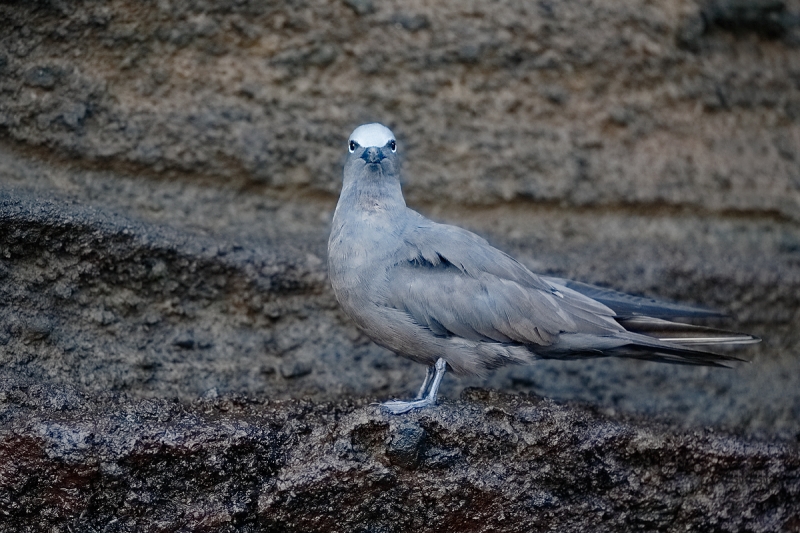
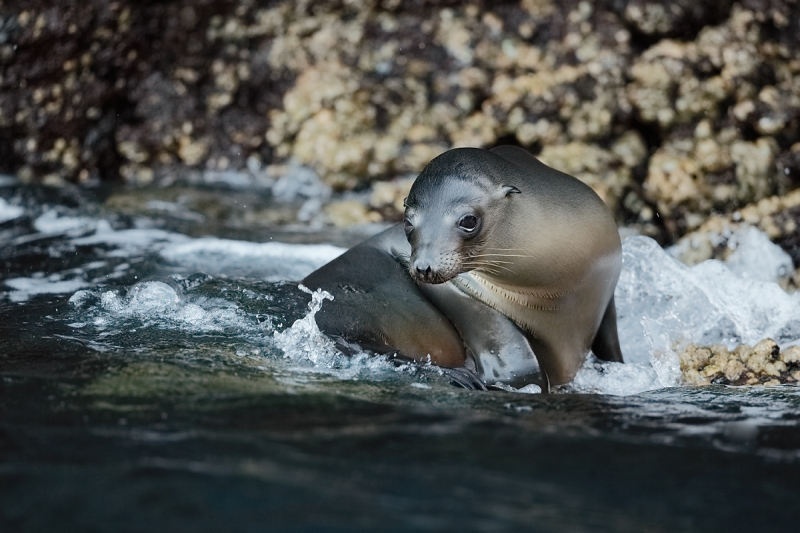
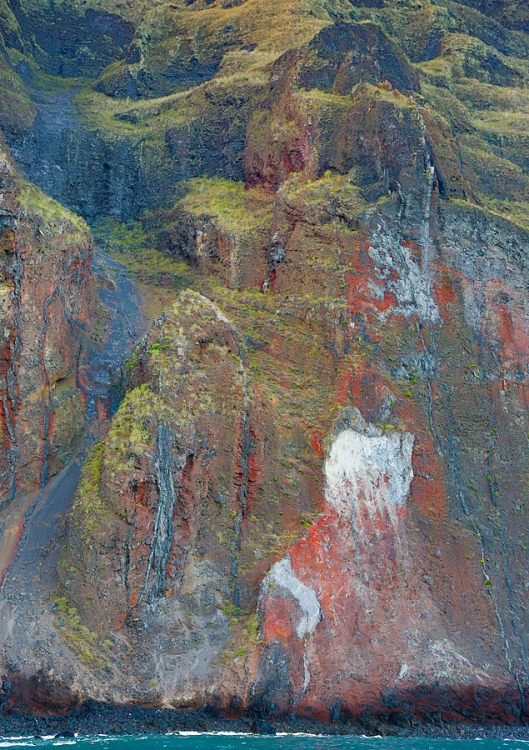
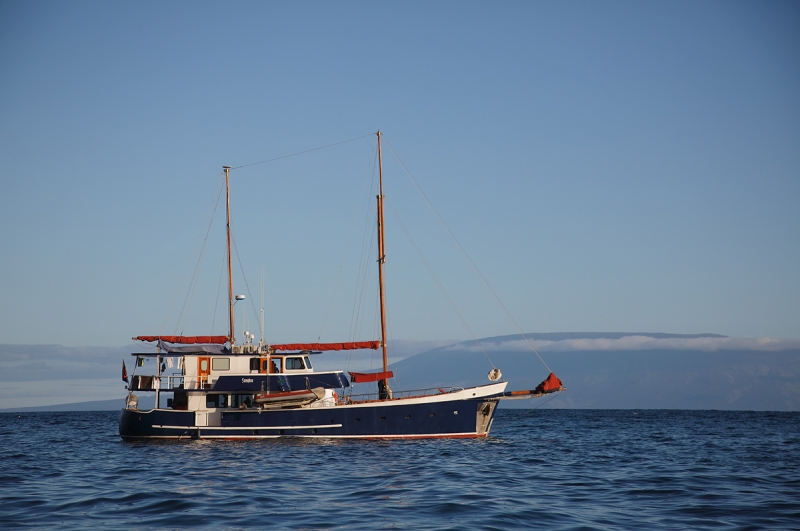
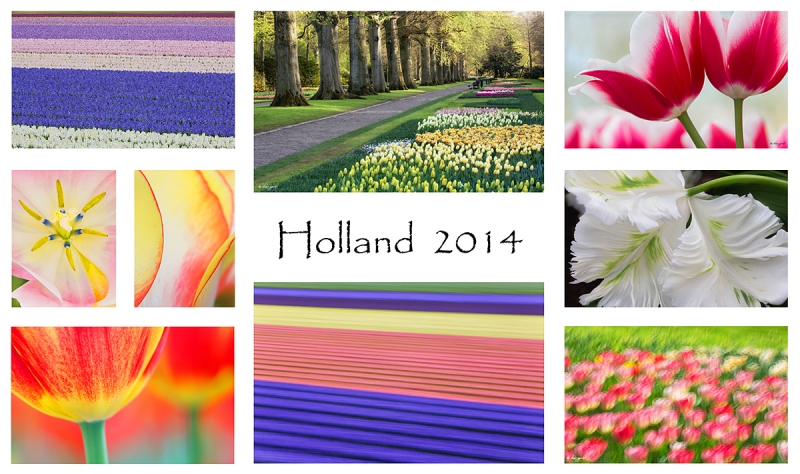
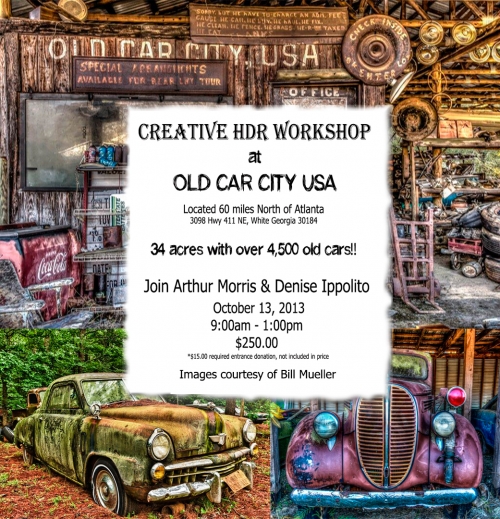













Thanks, Artie. Because of you, I spend a whole lot more time thinking about composition than I did before, and at least to my eyes, the improvement in my images is dramatic. So thank you again. I like the seal pup best, for texture, details, composition, and the animal itself. I love the brown noddy’s expression and stance but the background, at least to me, is rather unusual for you, and I don’t think it adds as much interest as it detracts. Maybe you’ve trained me too well.
Since you asked, and since you’ve written it twice recently, better to day “3 times as much space from the bird’s bill as from its tail” instead of “…than from its tail.”
Thanks David. Yeah, the background for the seal is less than ideal. We somewhat suffered from a dearth of subjects on that panga ride.
As for your phrasing suggestion, I will assume that you meant “better to say…”
Is the use of “as” there your preference or are you saying that “than” is grammatically incorrect? If the latter, I’d love to see some sort of proof 🙂
Hi, Artie. Yes, I have fat fingers and meant to type “better to say.” 🙂 On the other thing, I’m working by analogy. One wouldn’t say “Memphis is about twice as far from Chicago than St. Louis”; instead, one would say “Memphis is about twice as far from Chicago as St. Louis.” The sentence you wrote to compare the amount of space from the bird’s bill to the amount of space from its tail has exactly the same grammatical construction; it’s just a bit more complicated. So that’s my argument; it’s more than preference, but not quite proof.
Enjoy Africa, my home continent.
One minute I think that you are right, the next minute that you are wrong. I have written Mary Beacom Bowers, the first, longtime, and now retired editor of Bird Watcher’s Digest. She will not only know which is right but will know why. If I hear from her I will post her response.
Where were you born?
Cape Town. Lived there until I was about 17.
Thanks for the composition article. I think composition is the most undervalued parts of photography while in reality it is one of the most important ones.
A Nikon D4 or EOS 1DX are not enough for getting a good shot. Many people ignore composition way to often – I was as guilty about this any many others when I get serious about nature photography.
Looking forward to more such articles.
I like the tern image as it as. Great shot.
BTW, just bought your 1DX AF guide. Should get the 1DX this week, can’t wait to get everything out of the AF that that the camera has to offer.
Markus
The sea lion pup has a richness of color and texture that made it my choice
Art,
They are all nice shots. My preference would be:
1. The Samba; great light, composition, color and texture.
2. Sea Lion; great texture, composition and moment, though the background became a bit of a spoiler (I’m being picky here as sometimes there isn’t really much choice).
3. Sea & mountain; great texture and color.
4. Brown Noddy.